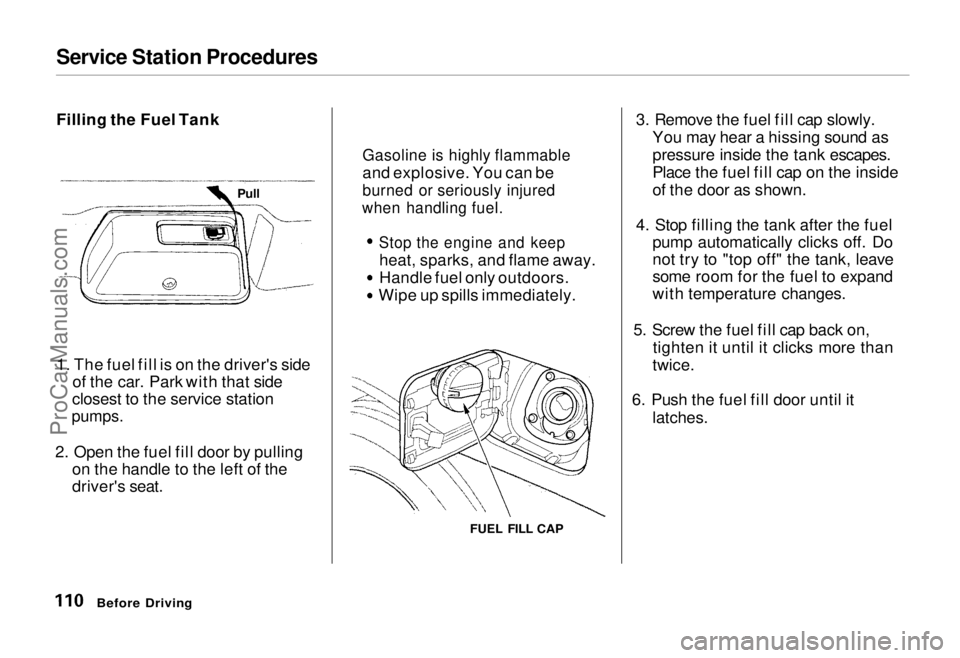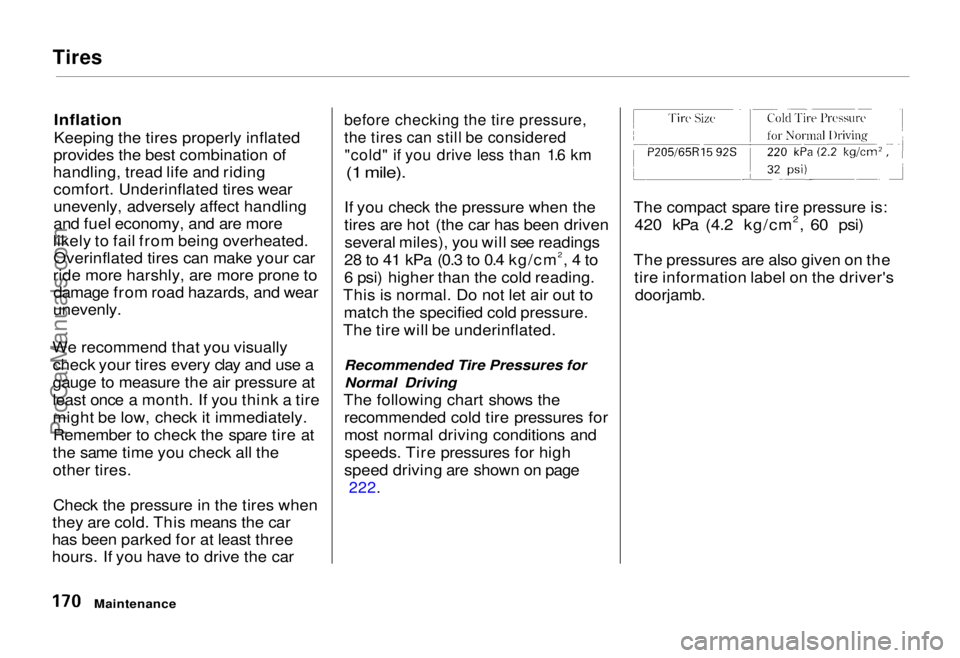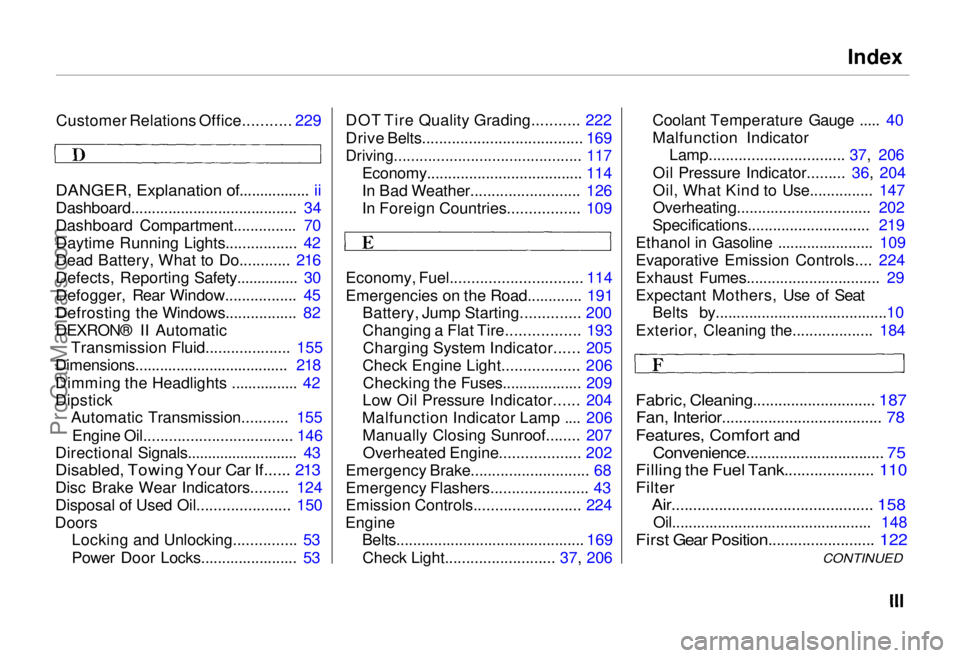1995 HONDA ODYSSEY fuel pressure
[x] Cancel search: fuel pressurePage 35 of 240

Indicator Lights
The instrument panel has many indicators to give you important
information about your car.
Lamp Check
Many of the indicator lights come on
when you turn the ignition switch ON (II), allowing you to see that they
are working. The instrument panel should look like the illustration. If an
indicator does not light during this
test, it cannot alert you if that system develops a problem. Have the dealer
check your car for burned-out bulbs
or other problems.
* The U.S. instrument panel is
shown. Differences for the Canadian
model are noted in the text.
Instruments and Controls
MALFUNCTION INDICATOR LAMP/
CHECK ENGINE LIGHT* PARKING BRAKE AND
BRAKE SYSTEM INDICATOR*
CRUISE CONTROLINDICATOR
DOOR AND BRAKE
LAMP MONITOR
HIGH BEAM
INDICATOR
LOW FUEL
INDICATOR
SUPPLEMENTAL RESTRAINT
SYSTEM INDICATOR LOW OIL PRESSURE
INDICATOR
ANTI-LOCK BRAKE
SYSTEM INDICATOR* CHARGING
SYSTEM
INDICATOR SEAT BELT
REMINDER
LIGHTProCarManuals.comMain Menu Table of Contents s t
Page 110 of 240

Service Station Procedures
Filling the Fuel Tank
1. The fuel fill is on the driver's side
of the car. Park with that side
closest to the service station
pumps.
2. Open the fuel fill door by pulling on the handle to the left of the
driver's seat.
FUEL FILL CAP3. Remove the fuel fill cap slowly.
You may hear a hissing sound as
pressure inside the tank escapes.
Place the fuel fill cap on the inside
of the door as shown.
4. Stop filling the tank after the fuel pump automatically clicks off. Do
not try to "top off" the tank, leave
some room for the fuel to expand
with temperature changes.
5. Screw the fuel fill cap back on, tighten it until it clicks more than
twice.
6. Push the fuel fill door until it
latches.
Before Driving
Gasoline is highly flammable
and explosive. You can be
burned or seriously injured
when handling fuel.
Stop the engine and keep
heat, sparks, and flame away.
Handle fuel only outdoors.
Wipe up spills immediately.
PullProCarManuals.comMain Menu Table of Contents s t
Page 114 of 240

Fuel Economy
The condition of your car and your driving habits are the two most
important things that affect the fuel
mileage you get.
Vehicle Condition Always maintain your car according to the maintenance schedule. This
will keep it in top operating condition.
An important part of that mainte- nance is the Periodic Checks (see
page 144). For example an under-inflated tire causes more "rolling
resistance," which uses fuel. It also
wears out faster, so check the tire
pressure at least monthly. In winter,
the build-up of snow on your car's
underside adds weight and rolling
resistance. Frequent cleaning helps
your fuel mileage and reduces the chance of corrosion. Driving Habits
You can improve fuel economy by driving moderately. Rapid acceler-
ation, abrupt cornering, and hard
braking use more fuel.
Always drive in the highest gear that allows the engine to run and acceler-
ate smoothly.
Depending on traffic conditions, try
to maintain a constant speed. Every
time you slow down and speed up,
your car uses extra fuel. Use the cruise control, when appropriate, to
increase fuel economy. A cold engine uses more fuel than a
warm engine. It is not necessary to "warm-up" a cold engine by letting it
idle for a long time. You can drive away in about a minute, no matter
how cold it is outside. The engine
will warm up faster, and you get better fuel economy. To cut down on
the number of "cold starts," try tocombine several short trips into one.
The air conditioning puts an extra load on the engine which makes ituse more fuel. Turn off the A/C to
cut down on air conditioning use.Use the flow-through ventilation
when the outside air temperature is moderate.
Before DrivingProCarManuals.comMain Menu Table of Contents s t
Page 143 of 240

Periodic Checks
You should check the following items at the specified intervals. If
you are unsure of how to perform any check, turn to the page given. Engine oil level — Check every
time you fill the fuel tank. See
page 112.
Engine coolant level — Check the
radiator reserve tank every time
you fill the fuel tank. See page 113.
Windshield washer fluid — Check the level in the reservoir monthly.If weather conditions cause you to
use the washers frequently, check
the reservoir each time you stop
for fuel. See page 154. Automatic transmission — Check
the fluid level monthly. See page
155.
Brakes and power steering —
Check the fluid level monthly. See
page 156.
Tires — Check the tire pressure
monthly. Examine the tread for
wear and foreign objects. See page
169.
Battery — Check its condition and
the terminals for corrosion monthly. See page 162. Air conditioning — Check its
operation weekly. See page 168. Lights — Check the operation of
the headlights, parking lights,
taillights, high-mount brake light,
turn signals, brake lights, and
license plate lights monthly. See
page 175.
Maintenance
ProCarManuals.comMain Menu Table of Contents s t
Page 169 of 240

Tires
Inflation
Keeping the tires properly inflated
provides the best combination of
handling, tread life and riding comfort. Underinflated tires wear
unevenly, adversely affect handling
and fuel economy, and are more
likely to fail from being overheated. Overinflated tires can make your car
ride more harshly, are more prone to damage from road hazards, and wear
unevenly.
We recommend that you visually check your tires every clay and use a
gauge to measure the air pressure at
least once a month. If you think a tire
might be low, check it immediately.Remember to check the spare tire at
the same time you check all the
other tires.
Check the pressure in the tires when
they are cold. This means the car
has been parked for at least three
hours. If you have to drive the car
before checking the tire pressure,
the tires can still be considered
"cold" if you drive less than 1.6 km
(1 mile).
If you check the pressure when the
tires are hot (the car has been driven several miles), you will see readings
28 to 41 kPa (0.3 to 0.4 kg/cm2, 4 to
6 psi) higher than the cold reading.
This is normal. Do not let air out to match the specified cold pressure.
The tire will be underinflated.
Recommended Tire Pressures forNormal Driving
The following chart shows the recommended cold tire pressures for
most normal driving conditions andspeeds. Tire pressures for high
speed driving are shown on page
222.
The compact spare tire pressure is:
420 kPa (4.2 kg/cm2, 60 psi)
The pressure
s
are also given on the
tire information label on the driver's
doorjamb.
MaintenanceProCarManuals.comMain Menu Table of Contents s t
Page 234 of 240

Index
Customer Relations Office........... 229
DANGER, Explanation of................. ii
Dashboard........................................ 34
Dashboard Compartment............... 70
Daytime Running Lights................. 42
Dead Battery, What to Do............ 216
Defects, Reporting Safety............... 30
Defogger, Rear Window................. 45
Defrosting the Windows................. 82
DEXRON® II Automatic Transmission Fluid.................... 155
Dimensions..................................... 218
Dimming the Headlights ................ 42
Dipstick Automatic Transmission........... 155
Engine Oil................................... 146
Directional Signals........................... 43
Disabled, Towing Your Car If...... 213
Disc Brake Wear Indicators......... 124
Disposal of Used Oil...................... 150
Doors Locking and Unlocking............... 53
Power Door Locks....................... 53 DOT Tire Quality Grading........... 222
Drive Belts...................................... 169
Driving............................................ 117
Economy..................................... 114
In Bad Weather.......................... 126
In Foreign Countries................. 109
Economy, Fuel............................... 114
Emergencies on the Road............. 191 Battery, Jump Starting.............. 200
Changing a Flat Tire................. 193
Charging System Indicator...... 205
Check Engine Light.................. 206 Checking the Fuses................... 209
Low Oil Pressure Indicator...... 204
Malfunction Indicator Lamp .... 206 Manually Closing Sunroof........ 207Overheated Engine................... 202
Emergency Brake............................ 68
Emergency Flashers....................... 43
Emission Controls......................... 224
Engine Belts............................................. 169
Check Light.......................... 37, 206 Coolant Temperature Gauge ..... 40
Malfunction Indicator
Lamp................................ 37, 206
Oil Pressure Indicator......... 36, 204
Oil, What Kind to Use............... 147
Overheating................................ 202
Specifications............................. 219
Ethanol in Gasoline ....................... 109
Evaporative Emission Controls.... 224
Exhaust Fumes................................ 29
Expectant Mothers, Use of Seat Belts by.........................................10
Exterior, Cleaning the................... 184
Fabric, Cleaning............................. 187
Fan, Interior...................................... 78
Features, Comfort and
Convenience................................. 75
Filling the Fuel Tank..................... 110
Filter Air............................................... 158
Oil................................................ 148
First Gear Position......................... 122
CONTINUEDProCarManuals.comMain Menu s t Main Menu s t
Page 236 of 240

Index
Instrument Panel............................. 34
Instrument Panel Brightness......... 43 Interior Cleaning............................ 187
Interior Lights.................................. 73
Introduction....................................... i
Jacking up the Car......................... 195
Jack, Tire........................................ 193
Jump Starting................................. 200
Keys................................................... 51
Label, Certification........................ 216
Lane Change, Signaling.................. 43
Lap Belt............................................... 7
Lap/Shoulder Belts........................... 6
Leaking of Exhaust into Car.......... 29
Lighter, Cigarette............................ 72
Lights Headlight Aiming...................... 175 Bulb Replacement..................... 177
Indicator........................................ 35
Parking.......................................... 42
Turn Signal................................... 43
Loading Cargo................................ 116
LOCK (Ignition Key Position)....... 52
Locks Anti-theft Steering Column........ 52
Fuel Fill Door............................. 110
Glove Box..................................... 55
Power Door.................................. 53
Tailgate......................................... 55
Low Coolant Level......................... 150
Low Oil Pressure Indicator.... 36, 204
Lubricant Specifications Chart.... 218
Luggage.......................................... 116
Maximum Speeds.......................... 123
Meters, Gauges................................ 39
Methanol in Gasoline.................... 109
Mirrors, Adjusting........................... 66
Neutral Gear Position.................... 122
New Vehicle Break-in ................... 108
NOTICE, Explanation of................... ii
Numbers, Identification................ 216
Occupant Protection System............ 4
Octane Requirement, Gasoline.... 108
Odometer.......................................... 39
Odometer, Trip................................ 39
Oil
Change, How to ......................... 148
Change, When to....................... 140
Checking Engine....................... 146
Pressure Indicator....................... 36
CONTINUED
Maintenance................................... 135
Periodic Items............................ 144
Record.................................142 - 143
Required Indicator....................... 40
Safety........................................... 136
Schedule............................ 138 - 141
Malfunction Indicator Lamp .. 37, 206ProCarManuals.comMain Menu s t
Page 240 of 240

Gas Station Information
Gasoline:
UNLEADED gasoline
Pump octane of 86 or higher
Fuel Tank Capacity:
65 l (17.2 US gal, 14.3 Imp gal)
Recommended Engine Oil:
API SG or SH grade "Energy Conserving II" oil
SAE 5W-30 viscosity
Engine Oil Capacity:
including filter
3.8 l (4.0 US qt, 3.3 Imp qt)
without filter 3.5 l (3.7
US qt, 3.1 Imp qt)
Tire Pressure (measured cold):
220 kPa (2.2 kg/cm2, 32 psi)
Spare Tire Pressure: 420 kPa (4.2 kg/cm2, 60 psi)
Tire Size (Front and Rear): P205/65R15 92S
Spare Tire: T135/90D15
Other Tire Information: See label on the driver's door-
jamb. Automatic Transmission Fluid:
Honda Premium Formula Auto-
matic Transmission Fluid or an
equivalent DEXRON ®
II type Auto-
matic Transmission Fluid (ATF)
Capacity:
2.4 l (2.5 US qt, 2.1 Imp qt)ProCarManuals.comMain Menu s t